Search this site
Catherine Opie Maps a Majestic Topography of Modern American Life

Chromogenic print, 40 × 50 in. (101.6 × 127 cm). Picture credit: courtesy the artist and Regen Projects, Los Angeles; Lehmann Maupin, New York/Hong Kong/Seoul/London; Thomas Dane Gallery, London and Naples; and Peder Lund, Oslo
Domestic (1995–98)
Over the past four decades, Catherine Opie has traversed the United States, exploring the people, places, and politics of a nation often at odds with itself. Coming into her own as the Culture Wars of the late 1980s raged, Opie made a way for herself by reimaging the traditions of documentary, portrait, and landscape photography.
In the new book, Catherine Opie (Phaidon), the artist looks back at her extraordinary archive of work, mapping an intimate and textured topography of modern American life. Featuring 300 photographs, including many never before published works, this immersive survey of Opie’s work reads as a portrait of a nation moving towards the brink. But at the same time, there is a sense of faith and hope, a belief in the possibility of individuals from all walks of life to come together in support of the greater good. Here Opie looks back on her journeys and shares insights gleaned along the way.
Could you speak about what it was like to begin your career at the height of the 1980s Culture Wars, and the ways in which these issues informed your approach to photography?
“I didn’t think that I would end up being an artist. I knew that I wanted to be an educator. At first I was going be a kindergarten teacher because I love children so much, and then it became clear to me that art was a passion that I was pushing down because my parents had told me I wouldn’t be able to make a it sustainable living — but it ended up winning out.
“I was formally trained under the school sensibility of photography: Robert Frank, Dorothea Lange, Walker Evans in a very traditional photographic program at the San Francisco Art Institute where they were reconfiguring the position of documentary art. It was really a boys club, that modernist approach to the way MoMA and SFMOMA collected photography.
“The Pictures Generation was coming up and I really loved street photography. That’s what I was predominantly doing in San Francisco, even when I was photographing my community for magazines like On Our Backs. I got to figure out my position within the medium and what I wanted to be able to talk about with making images.

Chromogenic print, 30 × 22 1?4 in. (76.2 × 56.5 cm). Picture credit: courtesy the artist and Regen Projects, Los Angeles; Lehmann Maupin, New York/Hong Kong/Seoul/London; Thomas Dane Gallery, London and Naples; and Peder Lund, Oslo.
High School Football (2007–9)
Could you speak about the way you use photography as a means to move through various communities and collaborate with them to explore their struggles and triumphs in America today?
“I had been living in San Francisco since the early ‘80s and would go to the Red Doors Lady coffee shop, meet people and asked them to sit for a portrait. That extended my community there. Photography has always given me the ability to reach out of my own discomfort and shyness, which I don’t have anymore because of teaching all these years. But I definitely had that in me for a long time. Even in grad school I wasn’t the talkative one; I was the one who hung back and listened.

Pigment print, 40 × 30 in. (101.6 × 76.2 cm). Picture credit: courtesy the artist and Regen Projects, Los Angeles; Lehmann Maupin, New York/Hong Kong/Seoul/London; Thomas Dane Gallery, London and Naples; and Peder Lund, Oslo.
700 Nimes Road (2010–12)

Chromogenic print, 20 × 16 in. (50.8 × 40.6 cm). Picture credit: courtesy the artist and Regen Projects, Los Angeles; Lehmann Maupin, New York/Hong Kong/Seoul/London; Thomas Dane Gallery, London and Naples; and Peder Lund, Oslo.
Portraits (1993–97)
Could you speak about how portraiture shapes, informs, and collapses the boundaries between the self and the other?
“I think portraiture is so interesting. We’re used to portraits defining the idea of celebrity or family. But I also grew up in a generation where Life and Look magazines were on the coffee table. Long form pictorial documentary representations from photographers like Robert Capa and the Magnum photographers were always in the back of my head.
“When I made portraits and photographing them on colored backgrounds, in the beginning it was to try to redefine what a portrait could do instead of photographing with black and white, which has been common at that time. I wanted to make a different kind of portrait in relationship to the architecture of the body. I’ve always been very formal in my work but it allowed for a different kind of formality within photography for myself that that was still within a documentary mode but also trying to redefine it. That was always really important to me.
“In terms of connecting to people, portraiture is a shared experience. I never think of a portrait as like the pure essence of a person; it’s a shared moment and it’s quiet where you can gaze upon the figure. I like that they’re they’re not these active shoots in which I have loud music playing and I’m asking people to strike a different pose every few seconds. They take a short period of time to make but also long enough time that I can get the person just to sit with me in a shared space.”

Pigment print, 30 × 45 in. (76.2 × 114.3 cm). Picture credit: courtesy the artist and Regen Projects, Los Angeles; Lehmann Maupin, New York/Hong Kong/Seoul/London; Thomas Dane Gallery, London and Naples; and Peder Lund, Oslo.
Yosemite (2015)

Platinum print, 2 1?4 × 6 3?4 in. (5.7 × 17.1 cm). Picture credit: courtesy the artist and Regen Projects, Los Angeles; Lehmann Maupin, New York/Hong Kong/Seoul/London; Thomas Dane Gallery, London and Naples; and Peder Lund, Oslo.
Freeways (1994–95)
Could you discuss your interest in the landscape, and the ways in which environment is an integral part of the development of identity?
“I really question nature photography. I think about landscape in that way of it ever shifting its own vulnerability, like the human body. In the last six or seven years, I’ve been thinking about notions of whose land is this, what is land to us, and what is nature to us – especially with us all carrying a camera in our pocket. How do we actually experience the kind of Grand Canyon now? Do we get out of our car, take a picture of it get on, drive off, post it to Instagram and that’s our experience?
“In the same way that I want people to sit with my portraits and be with people, I’m also asking the same of landscape. It’s all based on time because photography is based on time. Its meaning has unfolded greatly, especially in the past year of the pandemic, I went out in an RV again to photograph monuments that were removed and also state parks, asking bigger questions about what is land to us, who has access to it, and how can I begin to collapse that in relationship to work.
“That’s true with the last body of work as well rhetorical landscapes where you have the stop motion animated collages on monitors. It’s like being able to think of the body politics; there’s also a land politics and those are two areas where I find an enormous amount of ability to try to create a language about.”

Pigment print, 40 × 30 in. (101.6 × 76.2 cm). Picture credit: courtesy the artist and Regen Projects, Los Angeles; Lehmann Maupin, New York/Hong Kong/Seoul/London; Thomas Dane Gallery, London and Naples; and Peder Lund, Oslo.
Zero to Something (New Zealand) (2011)

Chromogenic print, 48 × 64 in. (121.9 × 162.6 cm). Picture credit: courtesy the artist and Regen Projects, Los Angeles; Lehmann Maupin, New York/Hong Kong/Seoul/London; Thomas Dane Gallery, London and Naples; and Peder Lund, Oslo.
High School Football (2007–9)
Could you offer insight or advice to artists working today seeking to use their work for activism and advocacy?
“Read the histories, really dig deep. Read fiction too, because it incorporates all these ideas and adds to our ability to traverse the world and see different opinions. The ability to access information now is so different and unique. I just turned 60 this year and I see this with my 19-year-old son. There are incredible advantages and certain disadvantages that will take hold in very specific ways. We have enough of an understanding of our political system and I think people feel disenfranchised because they feel it’s completely corrupt — but we can make a difference.”

Chromogenic print, 18 × 24 in. (45.7 × 61 cm). Picture credit: courtesy the artist and Regen Projects, Los Angeles; Lehmann Maupin, New York/Hong Kong/Seoul/London; Thomas Dane Gallery, London and Naples; and Peder Lund, Oslo.
Political Landscapes (2006–ongoing)

Chromogenic print, 50 × 40 in. (127 × 101.6 cm). Picture credit: courtesy the artist and Regen Projects, Los Angeles; Lehmann Maupin, New York/Hong Kong/Seoul/London; Thomas Dane Gallery, London and Naples; and Peder Lund, Oslo.
Surfers (2003)
All Images: © Catherine Opie.



